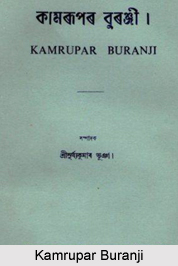 Historical and secular writings in Assamese Literature witnessed a new genre of Literature called Buranjis. Post modern age compliments the ushering of post modern tendencies in literature where the time-honoured concepts of bygone eras are put to the debating machines to weigh the pros and cons to gauge the possibilities and probabilities of judgement and of the events. While exploring the domains of historical writings it is often kept in mind that history and past, the two coinages hardly carry the analogous weight. History requires evidence covering the areas of importance with an attempt to understand and therefore interpreting the same. Due to the political change that occurred in Assam, the cultural and literary tide had undergone a change. The Ahoms popularised Buranjis or historical chronicles. These contain political records of different ruling dynasties. These historical works are numerous and voluminous. The Buranjis widened the frontiers of old Assamese literature and created an interest in secular subjects. For the first time literature showed signs of gradually emerging out of sombre grooves of religion and became precise in character.
Historical and secular writings in Assamese Literature witnessed a new genre of Literature called Buranjis. Post modern age compliments the ushering of post modern tendencies in literature where the time-honoured concepts of bygone eras are put to the debating machines to weigh the pros and cons to gauge the possibilities and probabilities of judgement and of the events. While exploring the domains of historical writings it is often kept in mind that history and past, the two coinages hardly carry the analogous weight. History requires evidence covering the areas of importance with an attempt to understand and therefore interpreting the same. Due to the political change that occurred in Assam, the cultural and literary tide had undergone a change. The Ahoms popularised Buranjis or historical chronicles. These contain political records of different ruling dynasties. These historical works are numerous and voluminous. The Buranjis widened the frontiers of old Assamese literature and created an interest in secular subjects. For the first time literature showed signs of gradually emerging out of sombre grooves of religion and became precise in character.
The following are the prominent historical chronicles: Purani Asama Buranji, Asama Buranji, Deodhai Asama Buranji, Ttmgkhungia Buranji, Kamrupar Buranji, Barpahi Buranji, Satsari Asama Buranji, Chakariphati Buranji, PadshahaBuranji and so on. Initially it was written in the native language but subsequently Assamese language was used. This laid the foundation of a secular political prose in Assamese language. A picturesque prose style was used to write the historical chronicles. The Buranji style is distinctive and characteristic which reflects the spoken language of the people and is direct. This has been one of the greatest gifts of the Ahoms to the Indo-Aryan language which has been responsible in endowing Assamese with the great glory of a tradition of writing archives and historical anecdotes in beautiful prose.
The Buranjis are basically records of diplomatic and political details with a restrained language and marked by considerable elegance of expression with not much rhetoric. The language used is eastern Assam speech. The epithets, metaphors, imageries and similes have been used judiciously accompanied with clever use of wit and wisdom. The seventeenth century witnessed several historical works and chronicles. The language of the Padshaha Buranji is combined with number of Perso-Arabic words like nikah, tamam, hararn-zada, haramkhor, takid, qazi, hazurnavis, farman and so on. It is through this Buranji, a variety was introduced into the existing pattern of Assamese prose. Buranji literature reached its pinnacle in the seventeenth century.
Buranjis are considered as the first political prose in Assamese as well as of scientific prose too. The scientific prose was logical and precise without any rhetoric.
A combination of attention to the structural considerations along with the finding and assessing of facts remain to be the water mark for these writings. Apart from sufficient efficiency to write well grammatically and stylistically, the writings are pregnant with an answer of a variety of questions. These questions are not limited solely to what happened; they include why and how. Addressing the background of the event, the principals are combined with significant dates, and the influence of the event upon future developments. This combination of structure and detailed factual analysis is what makes historical writing difficult, both for novices and even experienced writers.



















